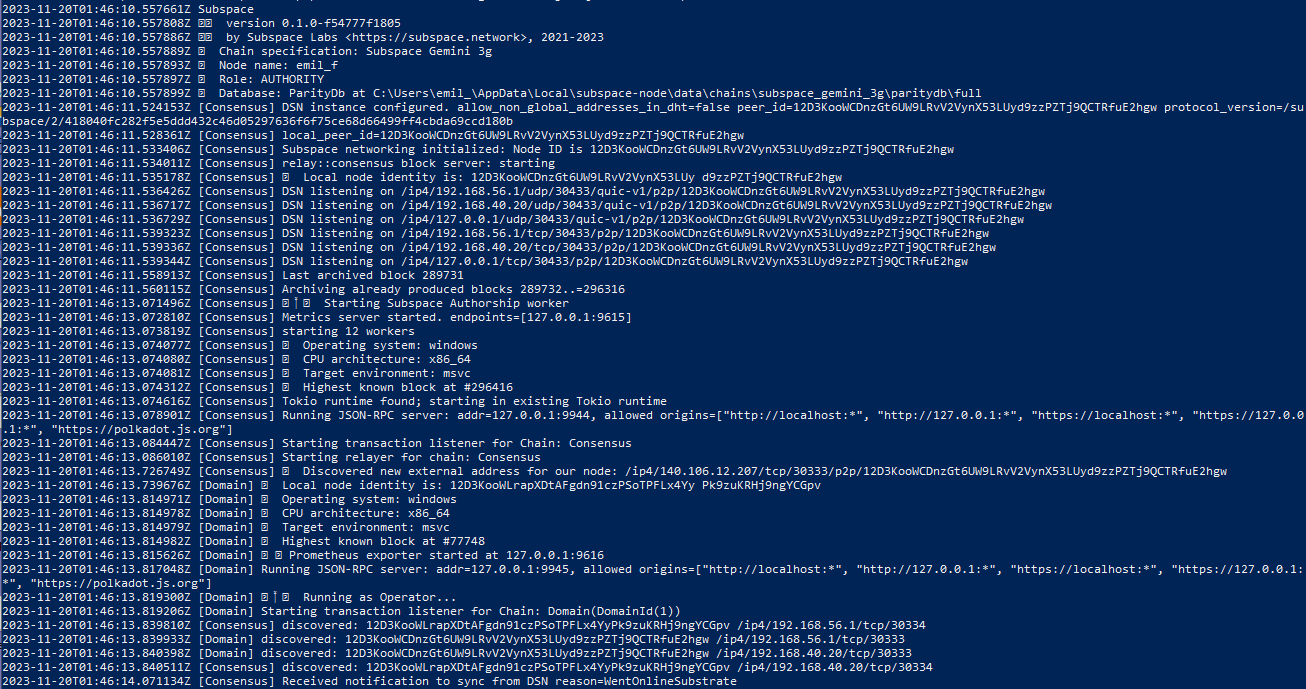Tips & Tricks
Insert key to Keystore:
This might be useful if you decided to switch domains or already have the secret phrase. Read more about switching domain in the next section.
To insert the key, use the following command:
<BASE_PATH>: Path to your node data directory<DOMAIN_ID>: The domain ID you want to operate on<SECRET_PHRASE>: Your operator key's secret phrase
./subspace-node-ubuntu-x86_64-skylake-taurus-2025-jul-14 domain key insert \
--base-path "<BASE_PATH>" --domain-id "<DOMAIN_ID>" --keystore-suri "<SECRET_PHRASE>"
The command above will insert the keypair in the subfolder of <BASE_PATH>/domains/<DOMAIN_ID>/keystore.
suri is the secret phrase of the operator key.
Switch domains
Any Operator can switch domain they operate on anytime. In order to switch domain:
- Proceed to PolkadotJS
- Make sure to select the correct network at the top-left corner.
- Select the account you want to use in
using the selected account. - Select
domainsundersubmit the following extrinsicand chooseswitchDomain(operatorId, newDomainId)in the dropdown. - Add your
operatorIdandnewDomainIdto the corresponding fields.

Only the account who registered Operator can switch the domain.
You need to move your keypair to a new location, if you switch domains. Follow the insert key to keystore section.
Stake of your Nominators won't be released, but will be moved to the new domain as well.
Useful commands
Running both validator (farmer) and operator nodes at the same time
To run both operator and validator at the same time, provide required flags for both roles when starting your node.
<NAME>: Ihr Knotenname für die Telemetrie<BASE_PATH>: Pfad zum Speichern der Knotendaten<DOMAIN_ID>: Domänen-ID, mit der Sie arbeiten möchten<OPERATOR_ID>: Your operator ID (obtained after registration)<WALLET_ADDRESS>: Your wallet address for farming rewards<FARM_SIZE>: Farm size (e.g. 4TiB, 8TiB)
- Ubuntu
- Windows
- macOS
- Docker
./subspace-node-ubuntu-x86_64-skylake-taurus-2025-jul-14 run \
--chain taurus \
--farmer \
--name "<NAME>" \
--base-path "<BASE_PATH>" \
--sync full \
-- \
--domain-id "<DOMAIN_ID>" \
--operator-id "<OPERATOR_ID>"
.\subspace-node-windows-x86_64-skylake-taurus-2025-jul-14.exe run `
--chain taurus `
--farmer `
--name "<NAME>" `
--base-path "<BASE_PATH>" `
--sync full `
-- `
--domain-id "<DOMAIN_ID>" `
--operator-id "<OPERATOR_ID>"
./subspace-node-macos-aarch64-taurus-2025-jul-14 run \
--chain taurus \
--farmer \
--name "<NAME>" \
--base-path "<BASE_PATH>" \
--sync full \
-- \
--domain-id "<DOMAIN_ID>" \
--operator-id "<OPERATOR_ID>"
services:
node:
# Replace snapshot-DATE with the latest release (like snapshot-2025-jan-07)
image: ghcr.io/autonomys/node:snapshot-DATE
volumes:
# Instead of specifying volume (which will store data in /var/lib/docker), you can
# alternatively specify path to the directory where files will be stored, just make
# sure everyone is allowed to write there
- node-data:/var/subspace:rw
# - /path/to/subspace-node:/var/subspace:rw
ports:
# If port 30333 or 30433 is already occupied by another Substrate-based node, replace all
# occurrences of 30333 or 30433 in this file with another value
- "0.0.0.0:30333:30333/tcp"
- "0.0.0.0:30433:30433/tcp"
- "0.0.0.0:40333:40333/tcp"
restart: unless-stopped
command: [
"run",
"--chain", "taurus",
"--base-path", "/var/subspace",
"--rpc-cors", "all",
"--rpc-methods", "unsafe",
"--rpc-listen-on", "0.0.0.0:9944",
"--farmer",
"--name", "<NAME>",
"--sync", "full",
"--",
"--domain-id", "<DOMAIN_ID>",
"--operator-id", "<OPERATOR_ID>",
"--listen-on", "/ip4/0.0.0.0/tcp/40333"
]
healthcheck:
timeout: 5s
# If node setup takes longer than expected, you want to increase interval and retries number.
interval: 30s
retries: 60
farmer:
depends_on:
node:
condition: service_healthy
# Replace snapshot-DATE with latest release (like snapshot-2025-jan-07)
image: ghcr.io/autonomys/farmer:snapshot-DATE
volumes:
# Instead of specifying volume (which will store data in /var/lib/docker), you can
# alternatively specify path to the directory where files will be stored, just make
# sure everyone is allowed to write there
- farmer-data:/var/subspace:rw
# - /path/to/subspace-farmer:/var/subspace:rw
ports:
# If port 30533 is already occupied by something else, replace all
# occurrences of 30533 in this file with another value
- "0.0.0.0:30533:30533/tcp"
restart: unless-stopped
command: [
"farm",
"--node-rpc-url", "ws://node:9944",
"--listen-on", "/ip4/0.0.0.0/tcp/30533",
"--reward-address", "<WALLET_ADDRESS>",
"path=/var/subspace,size=<FARM_SIZE>",
]
volumes:
node-data:
farmer-data:
You should see the node start successfully and begin syncing.

Switching to another server
To ensure the minimum downtime during your switch, we propose the following:
- Sync a new operator node using a throwaway key. You can generate a new key, just not insert it into your keystore.
- Stop the original node and rename the keystore (or whatever you feel comfortable doing to prevent you accidentally starting the original node up with the original signing key).
- Update the keystore on the new node with the original signing key.
- Restart the new operator node.